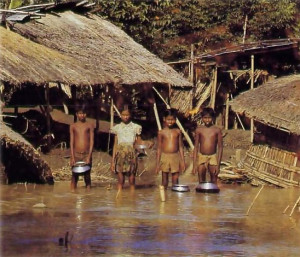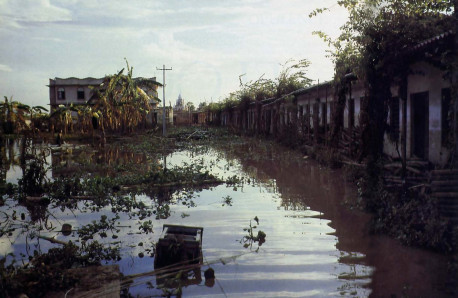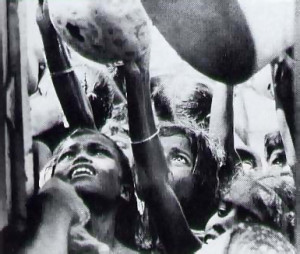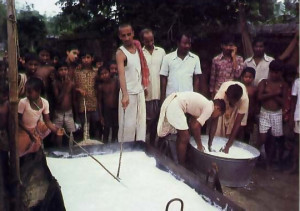West Bengal, India
By Nandarani Devi Dasi
 The flood last fall was devastating. One of the districts hardest hit was Nadia, where ISKCON’s center stands. Here one of the devotees relates how she and the others survived, and how they worked to bring relief to the villagers.
The flood last fall was devastating. One of the districts hardest hit was Nadia, where ISKCON’s center stands. Here one of the devotees relates how she and the others survived, and how they worked to bring relief to the villagers.
September 26:
The rain began last night. This morning the gardens were flooded and the unsheltered animals were running nervously up and down the high road. We didn’t know how long the rains would last, but we let the older boys out of class. They yoked the oxen sad began to move the wood and grain surplus to the big buildings. Others built rafts from toppled banana trees and carried passengers from one building to other. Bhavananda Maharaja began to move around the land, checking the kitchen, the handlooms, the dispensary and the school—arranging for everyone move to the upper floors of the new buildings. By nightfall, the high road was under 2 feet of water.

September 27:
This morning the water on the road measured 5 feet. The rain and winds are destroying everything around us. From the roof of the guesthouse we watched cowherd men as they moved our herd through the rushing floodwaters to higher land. The frightened animals battled the strong currents and tremendous winds for hours before reaching shelter.
We built an emergency rooftop kitchen and began cooking huge pots of kichari [a soup of lentils and rice]. Throughout the day the villagers arrived, begging shelter. As their straw houses floated past, they unloaded their salvaged possessions and their families on the first floors of our biggest buildings.
September 28:

The rain has not stopped; the water on the road is 10 feet deep. As we look from our roof we see only water and destruction in all directions. The villages to the north and east are demolished. Last night we rescued two cows, some buffaloes and a mongoose from the flood. The villagers are still arriving by boatload. They speak about whole settlements that have been swept away, along with their residents and livestock.
The most amazing phenomenon is that on every side of us there are calamities, but we never see an anxious look on the face of a devotee nor hear a nervous word. From Bhagavad-gita we learn that this material world has three types of miseries—those caused by other living entities, those caused by nature, and those caused by one’s own mind and body. For the people of Bengal this flood has certainly intensified all their miseries, but the devotees remain untouched by it. Because they know something of the plan of the Lord they can easily tolerate all miseries.
September 29:
The rain stopped early this morning but the water is steadily rising. The flood basement and first floors on the buildings are submerged and everyone has moved to the top floor and roof. The biggest danger is snakes, but the village boys keep guard on the verandas.
After surveying the flood damage, Bhavananda Maharaja began to speak: “Human life means plain living and high thinking. Therefore, we should not be excessively attached to our land, buildings or families. They can all be taken away in a moment. Because we are devotees we work hard to maintain these buildings for Krishna, knowing that everything belongs to Him. As long as we have a kitchen, we will cook prasada, offer it to Krishna and give it out to the people. As long as we have buildings we will give shelter. But if these buildings are swept away by this flood, does that mean we will not be able to give relief? No. At that time we will all board boats and go out to preach. Practicing service to Krishna and teaching that same service to others brings permanent relief from all the miseries of life.”
September 30:
Nitai Chand and a group of Bengali men left early this morning for Navadvipa (a small city across the Ganges], in hopes of getting supplies from the district government. After 14 hours they returned on a tiny wooden country boat with 4000 kilos of rice and a fantastic report of how they fought off looters, maneuvered their overladen boat through the narrow streets and finally battled the raging Ganges for 8 hours in order to bring the rice to Mayapur. By a special arrangement Nitai Chand got enough rice to feed the people sheltered in our buildings and to begin our relief work in the surrounding areas.
October 3:

The skies have been clear for two days. Everyone seems lighthearted, despite the ocean on all sides of us. Shortly after lunch we heard the unmistakable voice of Jayapataka Maharaja on a megaphone: HARE KRISHNA, HARE KRISHNA, KRISHNA KRISHNA, HARE HARE/ HARE RAMA, HARE RAMA, RAMA RAMA, HARE HARE. We ran to the south side of the building. He was there—coming through the floodwaters on a country boat laden with rice, wheat, chickpeas, vegetables, milk powder and fuel. A great cheer rang out from the devotees and villagers in all the buildings. After inspecting the conditions of the land and the devotees, Maharaja began to outline his emergency flood relief program. He said, “We should understand that we cannot actually give relief to anyone. A man suffers in this life because of sins committed in his previous life. We can fill his belly today, but tomorrow he will be hungry again. Similarly, we can alleviate one misery now, but if a man is sinful he will immediately get some other misery. Therefore, we should go to every village and give prasada [food purified by being offered to Lord Krishna]. Krishna promises in Bhagavad-gita that those who eat prasada are freed from all of their sins. Therefore, our prasada food relief program will have a double impact: it will fill the bellies of the hungry village people and simultaneously begin to alleviate the miseries each man bears because of his sins.”

Some people approached Maharaja and tried to discourage him from the flood relief project. Their points were valid. The floodwaters were 30 feet deep, and the swift currents could not be challenged by our 15-foot motor launch nor by the country boats. In addition, just below the surface of the waters lay hidden dangers—fallen poles with electric wires, trees, walls and fences, etc. Not only that, but we had all heard stories of looting and even murder for food. After weighing the pros and cons, Maharaja selected his crew and set the flood relief program into action.
October 4:
By 8:00 this morning the small launch was loaded with 400 kilos of flat rice mixed with soy oil, roasted chickpeas, salt and spices (a favorite village preparation). A loudspeaker was mounted on the top of the boat and connected to a tape recorder and microphone inside. With great faith we boarded the boat and headed south to Phukitala, a large settlement across the Sarasvati River. As we approached the high land we turned on the tape recorder and loudspeaker. The sound of the Hare Krishna mantra filled the air, and hundreds of villagers ran to the edge of the floodwater. It was just the sound they wanted to hear—the sound of relief.
Jayapataka Maharaja’s voice boomed out on the megaphone, calling for the village leaders and instructing the people to sit in lines with their bowls. Strong organization was imperative to avoid a frantic upheaval by the hungry people. At last they were seated, but the desperate latecomers lined up almost on top of them. Chaos broke loose, and again Maharaja called for the leaders to organize and control the crowd. At last the distribution began. Every child, woman and man got a full bowl of prasada. Some laughed, some cried and all chanted Hare Krishna, Hare Rama along with the loudspeaker.
October 6:
By 8:00 our boatful of prasada was heading north across an ocean of devastated houses, fields and roads. The heavy southeast current made our progress slow. Meanwhile, another team of devotees loaded fuel, uncooked rice, and lentils on a country boat and returned to Phukitala to set up a free kitchen for the stranded villagers.
Not more than 2 miles north of our temple we approached a half-submerged forest. Through his binoculars Jayapataka Maharaja spotted some rooftops, so at a snail’s pace we began to make our way through the trees and lush overgrowth. In a small clearing in the center there was enough high land to shelter about 100 people. They were completely cut off from the world outside their island of safety and had not seen any boats, planes, people or relief food since the flood began. The village was Muslim, and three-fourths of the people were women and children. The men had built temporary shelters for their families and cows. When they heard the sound of the Hare Krishna mantra they ran to the water’s edge. Some waded out and helped us maneuver the launch through the trees. Maharaja spoke briefly to them, saying that we had brought prasada, and that we would distribute it freely as soon as everyone was seated. To our surprise, all the children got their bowls and formed orderly rows with their mothers standing behind. The village men helped us unload the boat and everyone ate well.
October 7:
The launch was heavily loaded this morning and we set out north again. From the beginning we were slowed by cross-current and loose vines and wires in the water. One mile out we cut a course between two submerged jute fields. Yesterday we had passed the same way successfully, but today the current baffled us. The boat was heavy and there was every chance of getting bound up in the jute. By some fortune we skirted the jute field and gave the engine full power to head straight out. In a moment we hit a high road lying just beneath the water. The rudder stuck fast in the sand, the engine died, and the current swung the launch to the side and tipped it up at an 80 degree angle. Maharaja and Mayesvara (the photographer) jumped off to level the boat, while the other men assisted in freeing the rudder from the sand. Once we were off the road, the current swept us south—back toward the jute field. Rasaparayana tried to start the engine, but it was damaged. We grabbed the bamboo poles and sunk them deep in the mud, forcing the boat into open waters. At last we anchored. For two hours afterwards we floated in the flood waters, chanting Hare Krishna softly on our beads while Rasaparayana repaired the engine.

By 12:00 we were heading east toward Mayapur. We swung around and approached the village on the south side. There were no trees, but we cut our way through the ruins of what had been a prosperous village. We turned on the Hare Krishna loudspeaker, and Maharaja announced our program to the men on the shore. Suddenly people began to emerge from every corner of what remained of the village. They came toward us like a tidal wave, surrounding the boat, begging for food. Small children stuck their bowls in the boat windows and older boys tried to climb on board. The shoreline was jammed with women and babies, and faces peered out from each hut. Maharaja called for the village leader while our men held the crowd away from the boat. How could six of us organize and feed such an uncontrolled mass? Finally we came up with a plan. The village leader called for the head of each family by name. Each received 2 kilos of rice. The names were recorded, and each man waited his turn as we distributed from the front of the boat.
October 9:
The water level has dropped to about 10 feet in most areas. As the water recedes, our boat travel becomes more difficult. Every morning now we load three country boats with rice, lentils, wheat and fuel. One goes to Phukitala for the free kitchen. The others go to Balaudigi and Bamanpukar, two other settlements where the devotees run flood relief kitchens. They build a fire, cook 200 kilos of kichari, offer it to Krishna and distribute freely.
This morning the launch was loaded with a huge drum of cooked wheat and towed a country boat behind it with another 8 drums. We headed northeast toward the Muslim settlement of Needaya. When the course was too difficult for the launch, we anchored and went slowly through the trees and overgrowth on the country boat. By the time we got to the main settlement, 1000 people were gathered on the water’s edge. Jayapataka Maharaja called for the village leaders and once again we distributed prasada from the boat. Afterwards we inspected the temporary huts, the sanitation arrangement, and the livestock facility. We talked with the leaders about the needs of the settlement, and the number of homeless people. When the water subsides we will begin village redevelopment.
October 13:
This is the tenth day of the emergency food relief program. We have been working day and night. While some devotees cook, others load boats, and others remain in the village to staff the free kitchen. Supplies are coming daily from Calcutta, and donations are coming in from the West.
This morning a representative from CARE and newsmen from NBC, ABC, BBC and the local media came with us to the launch. We headed west to Indrakpur, a spread-out settlement of more than 3000 cowherds and their livestock. We anchored the launch at a distance from the village and tried to proceed in the wooden boat. The flood had subsided there and we moved slowly through the thick mud and water, struggling with the fallen trees and overgrowth. Several boys spotted us and came close. We sent them to call the people from all sides of the settlement because the boat could go no further. Soon they came—wading through the swampy fields with their children and their bowls. “Hare Krishna! Hare Rama!” they shouted as we distributed hundreds of kilos of wheat. With their help we pushed the boat back to deep water and then we returned to the temple.
October 14:
The temple grounds are still flooded but most of the northern villages are dry. The free kitchens are running successfully, but our village-to-village emergency work can no longer be done by boat. Now we will change to jeep or buffalo cart. The roads and railways are destroyed. The stagnant floodwaters breed cholera, smallpox and typhoid. The homeless people lie on the bare ground, completely dependent on God and His servants. Their crops are destroyed, their livestock drowned.
Now we will turn our attention toward rebuilding the villages. First there must be houses, then there must be looms. The weavers will work in co-ops and the village men will join to reconstruct the residences and the places of worship. At last the land must be cleared and planted. With Lord Krsna’s help, the devastated land of Bengal will again produce food for its people.


Excellent day by day account of the Kolkata floods of 1978. I was a small child then and could not fully enjoy the Durga Pujas that year.